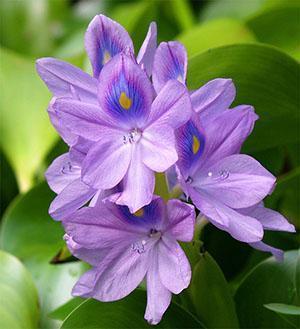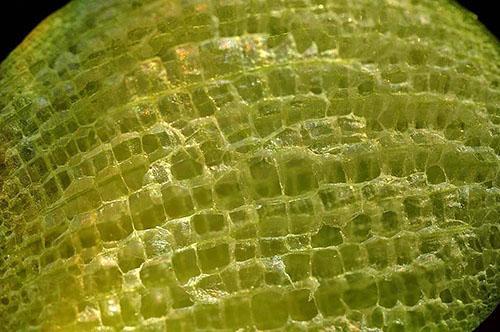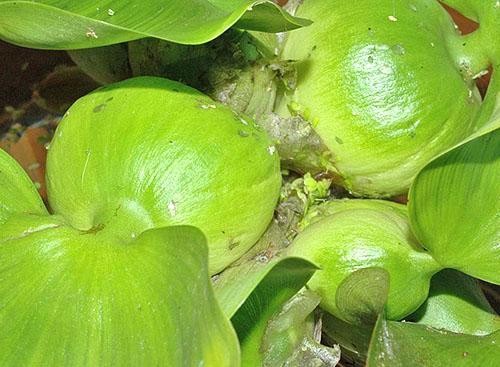Planting and caring for water hyacinths - advice from a professional!
 On the rivers and lakes of the South American continent, countries of Asia and Africa, water hyacinth Eichornia sometimes becomes a serious problem for the inhabitants of the surrounding villages, biologists, all local flora and fauna. Growing immensely in a warm environment, the culture completely closes the water surface of entire bodies of water, for which the water hyacinth deservedly received the nickname "water plague".
On the rivers and lakes of the South American continent, countries of Asia and Africa, water hyacinth Eichornia sometimes becomes a serious problem for the inhabitants of the surrounding villages, biologists, all local flora and fauna. Growing immensely in a warm environment, the culture completely closes the water surface of entire bodies of water, for which the water hyacinth deservedly received the nickname "water plague".
In areas with a temperate climate, a native from the tributaries of the Amazon cannot be found in the wild. But water hyacinth, as in the photo with graceful blue, purple and white flowers against a background of lush greenery, is desirable on artificial ponds, in winter gardens and large aquariums.
Water hyacinth Eichornia - species features

 Peculiar floats perfectly hold a green lush rosette with peduncles emanating from the center. The leaves of the water hyacinth Eichornia are rounded, leathery with arched veins. The flowering period of spectacular inflorescences does not exceed one day, and after wilting, the peduncle hides in the water column. And fibrous powerful roots can grow up to half a meter in length.
Peculiar floats perfectly hold a green lush rosette with peduncles emanating from the center. The leaves of the water hyacinth Eichornia are rounded, leathery with arched veins. The flowering period of spectacular inflorescences does not exceed one day, and after wilting, the peduncle hides in the water column. And fibrous powerful roots can grow up to half a meter in length.
Features of growing water hyacinth in a pond
 As exotic as the water hyacinth is, planting and caring for this crop is not as difficult as it sounds. The main thing is to create conditions close to natural conditions for the eichornia. The water for the habitat of the water hyacinth in the pond must be rich in organic components. As additives you can use:
As exotic as the water hyacinth is, planting and caring for this crop is not as difficult as it sounds. The main thing is to create conditions close to natural conditions for the eichornia. The water for the habitat of the water hyacinth in the pond must be rich in organic components. As additives you can use:
- humus;
- compost or mullein infusion;
- cleaned bottom sludge;
- complex fertilizers for aquarium plant species.
The growth of outlets is directly dependent on the nutrient content.
Water hyacinth Eichornia feels good in water with a slightly alkaline reaction and is not afraid even of impurities harmful to other aquatic flora. The powerful, highly branched roots of the plant expand under water and cover a huge volume like a pump, sucking not only organic matter, but also phosphates, traces of oils and phenols, insecticides and metal oxides. Therefore, this culture is today used for the purification of wastewater and sedimentation tanks.
In addition to the biochemical composition, it is extremely important for the culture to provide air and water temperatures close to the conditions of the subtropics.
When does water hyacinth bloom in nature?
 In Asia and South America, hyacinths grow at air temperatures not around +26 ° C. In the middle lane, such warm periods are not frequent. Flowering starts at + 28 ° C and stops already at + 22 ° C. Therefore, it is difficult to achieve annual flowering of aquatic culture to the north of the Chernozem region. But the closer to the south, the more actively the water hyacinth blooms in ponds and other bodies of water.
In Asia and South America, hyacinths grow at air temperatures not around +26 ° C. In the middle lane, such warm periods are not frequent. Flowering starts at + 28 ° C and stops already at + 22 ° C. Therefore, it is difficult to achieve annual flowering of aquatic culture to the north of the Chernozem region. But the closer to the south, the more actively the water hyacinth blooms in ponds and other bodies of water.
 If the summer is cold, a cap of rich green foliage grows magnificently over the water. For growing in a pond, water hyacinths are planted in May or June, when the water is already warm enough and there is no risk of cold snaps.
If the summer is cold, a cap of rich green foliage grows magnificently over the water. For growing in a pond, water hyacinths are planted in May or June, when the water is already warm enough and there is no risk of cold snaps.
Reproduction of the water hyacinth of Eichornia
 Typically, water hyacinth in a pond can be propagated vegetatively by separating young rosettes from mother plants. An increase in mass in eichornia occurs with a decrease in the duration of daylight hours, which can be used to collect planting material.
Typically, water hyacinth in a pond can be propagated vegetatively by separating young rosettes from mother plants. An increase in mass in eichornia occurs with a decrease in the duration of daylight hours, which can be used to collect planting material.

If in the reservoir, besides the water hyacinth, as in the photo, there is other vegetation, fish, amphibians or mollusks, excessive reproduction of Eichornia can lead to a change in the level of illumination and oxygen in the water, as well as to the death of flora and fauna. Hyacinth also propagates by seed. But for their ripening, an air temperature of at least + 35 ° C is required, which is practically unattainable in most regions of Russia.
Wintering water hyacinth
 With the arrival of autumn and a decrease in temperature, the water hyacinth Eichornia needs to be transferred to a lighted warm room. An aquarium, basin, or other suitable container can serve as a container for the winter stay of the plant. To fill the vessel, take the same water in which the hyacinth grew in summer. You can add silt in which Eichornia is able to root.
With the arrival of autumn and a decrease in temperature, the water hyacinth Eichornia needs to be transferred to a lighted warm room. An aquarium, basin, or other suitable container can serve as a container for the winter stay of the plant. To fill the vessel, take the same water in which the hyacinth grew in summer. You can add silt in which Eichornia is able to root.
- During wintering, eichornia no longer requires such a high temperature as in summer. It is enough that the room where the plant is kept is about + 20 ° C.
- The water should be at the same temperature.
- The rosettes of the water hyacinth in the photo are extremely sensitive to the lack of light, therefore they organize over the container with the plants backlight up to 14 hours a day.
- The plant should not lack oxygen, but drafts are very dangerous for water hyacinths.
- The constant evaporation of moisture, the level of which will have to be monitored until spring, does not affect the condition of the outlets too well.
To prevent the plant "starving" during the cold season, a little fertilizer for aquarium species is added to the water.
Water hyacinth - photo of use in landscape design
 For all its unpretentiousness and ability to reproduce, the water hyacinth Eichornia does not like drafts. Cattails, marsh irises and other vertically growing species along the water line will provide good plant protection. But water lilies can suffer from a growing neighbor.
For all its unpretentiousness and ability to reproduce, the water hyacinth Eichornia does not like drafts. Cattails, marsh irises and other vertically growing species along the water line will provide good plant protection. But water lilies can suffer from a growing neighbor.
As they grow, the sockets not only cover the surface of the reservoir from the sun's rays, but also reduce the oxygen content in the water. Therefore, it is important for other inhabitants of the pond to provide additional aeration of the water so that fish, shells and other aquatic animals do not feel discomfort. The population of water hyacinth in the pond requires constant monitoring, and at the first signs of abundant plant growth, they will have to be thinned out.